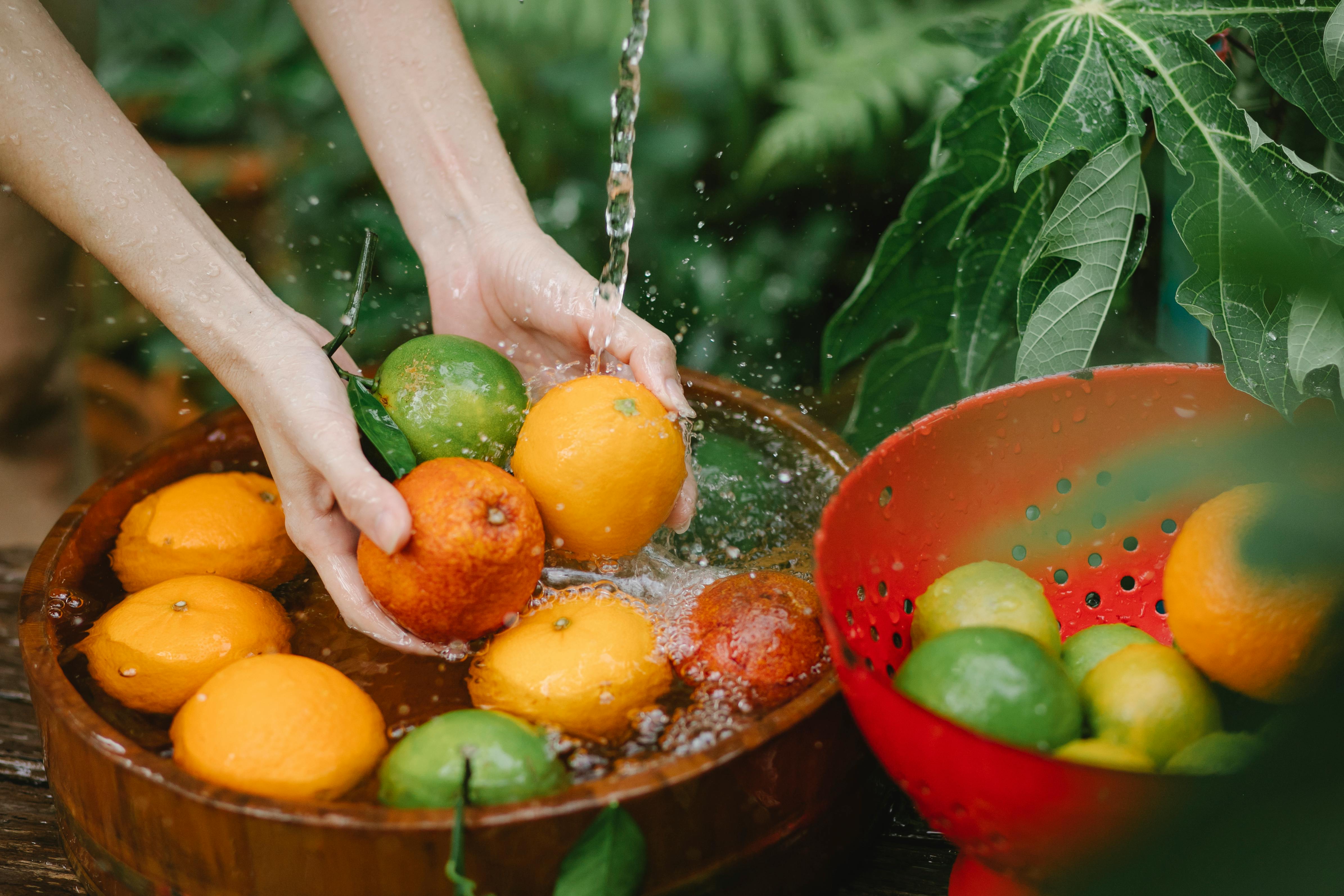Washing fruits with baking soda is an effective and natural way to remove any unwanted residue or bacteria from your produce. Baking soda is a natural cleaning agent that can be used as an alternative to traditional produce washes. It’s also safe to use on all types of fruits, including soft-skinned varieties like berries and grapes. In this article, we’ll explain how to safely wash fruit with baking soda so you can enjoy your produce without worry.Baking Soda, also known as bicarbonate of soda or sodium bicarbonate, is a naturally occurring alkaline substance. It is commonly used in baking and as a natural cleaning agent in households. Baking soda is often used to leaven baked goods, such as cakes and muffins, by releasing carbon dioxide gas when combined with an acidic ingredient like vinegar or lemon juice. Additionally, it can be used to make effective cleaning solutions for everyday spills and messes.
How to Clean Fruit with Baking Soda
Fruit is an excellent source of essential vitamins and minerals, but it can also carry a lot of dirt and germs. Fortunately, you can easily clean fruit with baking soda. Baking soda is a natural, non-toxic cleaning agent that can help remove pesticides and other impurities from the surface of the fruit. Here’s how to use baking soda to clean your fruit.
First, fill a bowl or basin with cool water. Add one tablespoon of baking soda for every quart (four cups) of water used. Stir the baking soda into the water until it’s fully dissolved. Soak the fruit in the solution for 10 minutes or longer, depending on how dirty the fruit is.
After soaking, rinse off the fruit with cool running water and gently scrub any remaining dirt away with a soft brush or cloth. You may also want to use a vegetable brush if you have one handy. Finally, dry off the fruit thoroughly before eating or storing it in the refrigerator.
It’s important to note that while this method will help remove some impurities from your fruit, it won’t eliminate all bacteria and germs from its surface. For best results, make sure you wash your hands thoroughly before handling any produce and always store fruits and vegetables in clean containers in your refrigerator.
Benefits of Washing Fruit with Baking Soda
Washing fruit with baking soda is a simple and effective way to remove dirt, bacteria, and other contaminants. Baking soda is a mild alkali that helps break down dirt and grime, making it easier to rinse off the fruit. It also helps reduce the amount of pesticides that may be present on the fruit. Additionally, baking soda can help reduce the amount of wax on certain types of produce, making them less slippery and easier to handle.
Baking soda also has antibacterial properties that can help reduce the risk of foodborne illnesses caused by harmful bacteria such as E. coli and Salmonella. When used correctly, washing fruit with baking soda can help reduce the risk of food contamination and make fruits and vegetables safer to consume.
Another benefit of washing fruit with baking soda is that it can help preserve the nutritional content of fresh produce. By removing dirt and contaminants from fruits and vegetables, it allows for better absorption of nutrients such as vitamins A, C, and K as well as minerals like iron, magnesium, and calcium.
In addition to these benefits, washing fruit with baking soda can also be an environmentally friendly choice since it does not require any harsh chemicals or detergents that could be damaging to ecosystems or water sources. This makes it a great option for those who are looking for an eco-friendly way to clean their produce.
Overall, washing fruit with baking soda is an easy and effective way to remove dirt, bacteria, waxes, pesticides, and other contaminants from fresh produce while preserving its nutritional content. It is also an environmentally friendly choice that requires no harsh chemicals or detergents making it a great option for those who care about protecting our environment.
Step 1: Rinse Fruit
Begin by rinsing the fruit with cool, running water. This will help to loosen any dirt or debris that may be on the outside of the fruit. It is important to avoid using warm or hot water, as this can cause the fruit to absorb excess water and become mushy. After rinsing, dry the fruit with a clean towel or paper towels.
Step 2: Prepare Baking Soda Solution
In a medium-sized bowl, mix together a solution of one part baking soda and three parts cool water. This mixture should be enough to submerge all of the fruit you are washing. If needed, you can adjust this ratio to make more or less solution depending on how much fruit you are washing.
Step 3: Soak Fruit in Solution
Once the solution is prepared, add the fruit and let soak for 10 minutes. During this time, the baking soda will help to draw out any residual dirt and bacteria that may be on the outside of the fruit. After 10 minutes have passed, remove the fruit from the solution and rinse thoroughly with cool running water once more.
Step 4: Dry Fruit Thoroughly
Using a clean towel or paper towels, pat the outside of each piece of fruit dry before consuming or storing away for later use. It is important that no excess moisture is left on the surface of each piece of fruit before it is stored away in order to prevent mold growth.

Proper Amount of Baking Soda to Use
Using baking soda is an effective way to add a nice flavor and texture to your baking recipes. The amount of baking soda you need to use will vary depending on the recipe and the type of dish you are making. Generally speaking, the recommended amount of baking soda is 1 teaspoon per cup of flour for most recipes. However, if your recipe calls for more than one cup of flour, you may need to increase the amount of baking soda accordingly.
When using baking soda for a recipe, it is important to remember that too much can cause an unpleasant taste or texture in the finished product. If you are unsure how much baking soda to use in a recipe, start with a smaller amount and gradually increase until you get the desired results. Additionally, it’s also important to note that different recipes may require different amounts of baking soda depending on the type of ingredients used.
It’s also important to keep in mind that some recipes may call for other ingredients such as vinegar or cream of tartar when using baking soda. This is because these ingredients help neutralize some of the acidity in the batter or dough, which can help create a more balanced flavor and texture in the finished product. If your recipe calls for these additional ingredients, make sure to add them in addition to the proper amount of baking soda.
When using baking soda for your recipes, it’s important to remember that too little or too much can have an effect on how well your dishes turn out. The proper amount will depend on the specific recipe you are making and should be adjusted accordingly as necessary. If you follow these tips and use just enough baking soda, you should be able to achieve great results every time!
Rinsing and Drying the Fruit after Washing with Baking Soda
After washing the fruit with baking soda, it is important to rinse and dry them thoroughly. This will help remove any excess baking soda from the fruit, as well as any dirt or debris that may remain. When rinsing, it is best to use cold water since hot water can cause the baking soda to dissolve more quickly. After rinsing, gently pat the fruit dry with a clean towel or paper towel. Make sure all moisture is removed so that the fruit does not become soggy. Once dried, store the fruit in a cool, dry place until ready to be used.
It is important to remember that fruits washed with baking soda should not be consumed raw since there may still be some residue remaining on them. Additionally, be sure to rinse all utensils used when washing fruit with baking soda before using them for other food preparation tasks in order to avoid cross-contamination.
Alternatives to Washing Fruit with Baking Soda
Fruits and vegetables are essential for a healthy diet. To ensure they are free from dirt, pesticides, and other contaminants, it is important to thoroughly wash them before consuming. While baking soda has traditionally been used as a method of cleaning fruits and vegetables, there are other alternatives available.
One option is to use vinegar. Vinegar is a natural disinfectant and can be used to remove residual dirt and bacteria from the surface of fruits and vegetables. To use vinegar for washing fruit, mix one part white vinegar with three parts water in a bowl or spray bottle. Soak the fruit in the mixture for several minutes, then rinse it off with cold water.
Another option is to use lemon juice or lime juice as an alternative to baking soda for washing fruit. Lemon juice is high in citric acid, which can help remove dirt and bacteria from the surface of fruits and vegetables. To use lemon juice for washing fruit, mix one part freshly squeezed lemon or lime juice with three parts water in a bowl or spray bottle. Soak the fruit in the mixture for several minutes, then rinse off with cold water.
Salt can also be used as an alternative to baking soda when washing fruits and vegetables. Salt can help draw out moisture from fruits and vegetables while also removing dirt and bacteria from their surfaces. To use salt for washing fruit, mix one tablespoon of salt with two cups of water in a bowl or spray bottle. Soak the fruit in the mixture for several minutes, then rinse off with cold water.
Finally, produce wash is another alternative to baking soda when cleaning fruits and vegetables. Produce wash is specifically designed to remove dirt, bacteria, pesticides, waxes, fungicides, herbicides, and other contaminants from produce surfaces without leaving behind any residue or taste-altering chemicals. To use produce wash when cleaning fruits and vegetables, simply spray it onto the surface of the produce item before rinsing off with cold water.
Ultimately, while baking soda has traditionally been used as a method of cleaning fruits and vegetables there are other alternatives available such as vinegar, lemon juice or lime juice, salt or produce wash that can be just as effective at cleaning produce surfaces without leaving behind any residue or taste-altering chemicals

Conclusion
Washing fruit with baking soda is an effective and easy way to remove dirt, pesticides, and other contaminants. It’s also a great way to add some extra flavor to your fruit. Baking soda works by breaking down the dirt and oils on the surface of the fruit, making it easier to remove. Plus, it doesn’t require any additional chemicals or detergents, so it’s safe for consumption. The best part about washing fruit with baking soda is that it’s quick and easy to do – all you need is a bowl of water and a couple of tablespoons of baking soda!
So if you’re looking for an effective and easy way to clean your fruits before eating them, give baking soda a try! You may find that it’s just as effective as other methods such as washing with vinegar or using a commercial produce wash. Plus, it doesn’t require any additional chemicals or detergents, so it’s safe for consumption. With just a few simple steps, you can have clean and flavorful fruits in no time!



